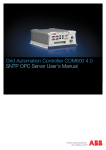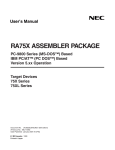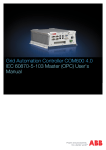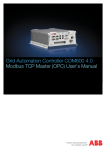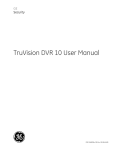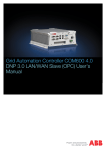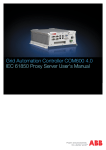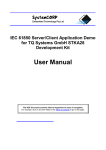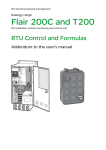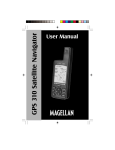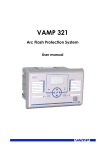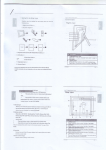Download External OPC Client Access User`s Manual
Transcript
Grid Automation Controller COM600 4.0 External OPC Client Access User's Manual 1MRS755564 Grid Automation Controller COM600 4.0 Issued: 10.03.2005 Version: H/31.5.2012 External OPC Client Access User's Manual Contents: 1. About this manual .................................................................................. 5 1.1. 1.2. 1.3. 1.4. 1.5. 1.6. 1.7. 1.8. 1.9. 2. Introduction ........................................................................................... 11 2.1. 2.2. 2.3. 3. Copyrights ...................................................................................... 5 Trademarks .................................................................................... 5 General .......................................................................................... 5 Document conventions .................................................................. 6 Use of symbols .............................................................................. 6 Terminology .................................................................................... 7 Abbreviations ................................................................................. 8 Related documents ........................................................................ 9 Document revisions ..................................................................... 10 About this section ......................................................................... 11 COM600 with 3rd party OPC Client ............................................. 11 Common features of OPC servers of COM600 ........................... 12 Accessing OPC servers of COM600 .................................................. 13 3.1. 3.2. 3.3. 3.4. 3.5. 3.6. About this section ......................................................................... 13 Requirements for the OPC Client ................................................ 13 COM600 OPC servers ................................................................. 13 Data access ................................................................................. 14 Alarms and Events ....................................................................... 19 DCOM configuration .................................................................... 22 Index .............................................................................................................. 23 3 4 1MRS755564 Grid Automation Controller COM600 4.0 External OPC Client Access User's Manual 1. About this manual 1.1. Copyrights The information in this document is subject to change without notice and should not be construed as a commitment by ABB Oy. ABB Oy assumes no responsibility for any errors that may appear in this document. In no event shall ABB Oy be liable for direct, indirect, special, incidental, or consequential damages of any nature or kind arising from the use of this document, nor shall ABB Oy be liable for incidental or consequential damages arising from use of any software or hardware described in this document. This document and parts thereof must not be reproduced or copied without written permission from ABB Oy, and the contents thereof must not be imparted to a third party nor used for any unauthorized purpose. The software or hardware described in this document is furnished under a license and may be used, copied, or disclosed only in accordance with the terms of such license. © Copyright 2012 ABB. All rights reserved. 1.2. Trademarks ABB is a registered trademark of ABB Group. All other brand or product names mentioned in this document may be trademarks or registered trademarks of their respective holders. 1.3. General This user’s manual provides thorough information on Station Automation COM600 (later referred to as COM600), focusing on giving instructions of how a 3rd party OPC Client can access the OPC servers of COM600. Information in this user’s manual is intended for application engineers who have to access the OPC servers of COM600 with a 3rd party OPC Client and have to configure the different components. As a prerequisite, you must have basic knowledge of client and server architectures in general. 5 1MRS755564 Grid Automation Controller COM600 4.0 External OPC Client Access User's Manual 1.4. Document conventions The following conventions are used for the presentation of material: • The words in names of screen elements (for example, the title in the title bar of a window, the label for a field of a dialog box) are initially capitalized. • Capital letters are used for the name of a keyboard key if it is labeled on the keyboard. For example, press the ENTER key. • Lowercase letters are used for the name of a keyboard key that is not labeled on the keyboard. For example, the space bar, comma key, and so on. • Press CTRL+C indicates that you must hold down the CTRL key while pressing the C key (to copy a selected object in this case). • Press ESC E C indicates that you press and release each key in sequence (to copy a selected object in this case). • The names of push and toggle buttons are boldfaced. For example, click OK. • The names of menus and menu items are boldfaced. For example, the File menu. • The following convention is used for menu operations: MenuName > MenuItem > CascadedMenuItem. For example: select File > New > Type. • The Start menu name always refers to the Start menu on the Windows taskbar. • System prompts/messages and user responses/input are shown in the Courier font. For example, if you enter a value out of range, the following message is displayed: Entered value is not valid. The value must be 0 - 30 • • . You can be asked to enter the string MIF349 in a field. The string is shown as follows in the procedure: MIF349 Variables are shown using lowercase letters: sequence name 1.5. Use of symbols This publication includes warning, caution, and information icons that point out safetyrelated conditions or other important information. It also includes tip icons to point out useful information to the reader. The corresponding icons should be interpreted as follows. The electrical warning icon indicates the presence of a hazard which could result in electrical shock. The warning icon indicates the presence of a hazard which could result in personal injury. 6 1MRS755564 Grid Automation Controller COM600 4.0 External OPC Client Access User's Manual The caution icon indicates important information or warning related to the concept discussed in the text. It may indicate the presence of a hazard which could result in corruption of software or damage to equipment or property. The information icon alerts the reader to relevant facts and conditions. The tip icon indicates advice on, for example, how to design your project or how to use a certain function. 1.6. Terminology Term Description Alarm An abnormal state of a condition. Alarms and Events; AE An OPC service for providing information about alarms and events to OPC clients. Data Access; DA An OPC service for providing information about process data to OPC clients. Data Object; DO Part of a logical node object representing specific information, for example, status, or measurement. From an object-oriented point of view, a data object is an instance of a class data object. DOs are normally used as transaction objects; that is, they are data structures. Data Set The data set is the content basis for reporting and logging. The data set contains references to the data and data attribute values. Device A physical device that behaves as its own communication node in the network, for example, protection relay. Event Change of process data or an OPC internal value. Normally, an event consists of value, quality, and timestamp. Intelligent Electronic Device A physical IEC 61850 device that behaves as its own communication node in the IEC 61850 protocol. Logical Device; LD Representation of a group of functions. Each function is defined as a logical node. A physical device consists of one or several LDs. Logical Node; LN The smallest part of a function that exchanges data. An LN is an object defined by its data and methods. LON A communication protocol developed by Echelon. 7 Grid Automation Controller COM600 4.0 1MRS755564 External OPC Client Access User's Manual Term Description LON Application Guideline for substation automation; LAG A proprietary method of ABB on top of the standard LON protocol. OPC Series of standards specifications aiming at open connectivity in industrial automation and the enterprise systems that support industry. OPC item Representation of a connection to the data source within the OPC server. An OPC item is identified by a string <object path>:<property name>. Associated with each OPC item are Value, Quality, and Time Stamp. Property Named data item. Report Control Block The report control block controls the reporting processes for event data as they occur. The reporting process continues as long as the communication is available. SPA ABB proprietary communication protocol used in substation automation. SPA device Protection and/or Control Product supporting the SPA protocol version 2.5 or earlier. Substation Configuration Lan- XML-based description language for configurations of electrical guage; SCL substation IEDs. Defined in IEC 61850 standard. 1.7. Abbreviations Abbreviation AE Alarms and Events ASDU Application Service Data Unit BRCB Buffered Report Control Block DA DMCD Data Access Data Message Code Definition DO Data Object GW Gateway, component connecting two communication networks together HMI Human Machine Interface IEC International Electrotechnical Commission IED Intelligent Electronic Device LAG LON Application Guideline for substation automation LAN Local Area Network LD 8 Description Logical Device 1MRS755564 Grid Automation Controller COM600 4.0 External OPC Client Access User's Manual Abbreviation LMK LN LonMark interoperable device communicating in LonWorks network. In this document, the term is used for devices that do not support the ABB LON/LAG communication. Logical Node LSG LON SPA Gateway NCC Network Control Center NUC Norwegian User Convention NV Network Variable OLE Object Linking and Embedding OPC OLE for Process Control P&C Protection & Control PLC Programmable Logic Controller POU Program Organization Unit RTS Request To Send SA Substation Automation SCD Substation Configuration Description SCL Substation Configuration Language SFC Sequential Function Chart SLD Single Line Diagram SNMP Simple Network Management Protocol SNTP Simple Network Time Protocol SOAP Simple Object Access Protocol RCB URCB XML 1.8. Description Report Control Block Unbuffered Report Control Block eXtended Markup Language Related documents Name of the manual MRS number COM600 User’s Manual 1MRS756125 9 1MRS755564 Grid Automation Controller COM600 4.0 External OPC Client Access User's Manual 1.9. Document revisions Document version/date 10 Product revision History A/10.3.2005 1.0 Document created B/16.10.2006 3.0 Document revised C/21.12.2007 3.1 Document revised D/17.6.2008 3.2 Document revised E/13.2.2009 3.3 Document revised F/06.11.2009 3.4 Document revised G/30.6.2011 3.5 Document revised H/31.5.2012 4.0 Document revised 1MRS755564 Grid Automation Controller COM600 4.0 External OPC Client Access User's Manual 2. Introduction 2.1. About this section In this section, you will find an overview of a typical system with COM600 and a 3rd party OPC Client accessing the OPC servers of this gateway. This section also gives an overview of the internal structure of COM600 as well as of COM600 OPC servers. 2.2. COM600 with 3rd party OPC Client Below you can see an overview of a typical COM600 system with a third party OPC Client. overview.jpg Figure 2.2-1 System overview 1. 2. 3. 4. 5. Station Automation Builder 600 (SAB600) COM600 NCC 3rd party system with an OPC Client Protection and control devices COM600 uses OPC servers for master/client protocol stacks to provide access to the data in the devices connected to COM600. COM600 slave OPC clients use these OPC 11 Grid Automation Controller COM600 4.0 1MRS755564 External OPC Client Access User's Manual servers internally to provide data for remote systems with a certain communication protocol. Each slave OPC Client component includes a small OPC Data Access server for diagnostic and control purposes. External OPC Clients can also access the OPC servers of COM600 if enabled in the COM600 license. Third party control systems with OPC Client can therefore easily access data from COM600 without using any conventional communication protocol. External OPC Clients are connected to COM600 via LAN using DCOM. DCOM must be configured both in the client computer and in COM600 to allow the access. More about DCOM configuration is explained in 3.6, DCOM configuration. 2.3. Common features of OPC servers of COM600 • • • • • • 12 Supports OPC Data Access 1.0/2.0 specification for process and diagnostic data OPC namespace and process data modeled according the IEC61850 standard Update rate zero supported on OPC DA for no-loss-of-events based update OPC DA items timestamped by the source device when applicable by the protocol and device OPC items for system supervision and communication diagnostic and control Supports OPC Alarm&Event 1.10 specification for process and diagnostic data 1MRS755564 Grid Automation Controller COM600 4.0 External OPC Client Access User's Manual 3. Accessing OPC servers of COM600 3.1. About this section In this section, there is a list of the requirements that have to met by the 3rd party OPC Client as well as information on Windows settings (user IDs, DCOM). This section also gives you an overview of how to access the OPC servers of COM600 with a 3rd party OPC Client. 3.2. Requirements for the OPC Client • • • • 3.3. Windows 2000 or XP operating system Support for OPC Data Access 2.0 Specification LAN/DCOM connection to COM600 Possibility to modify DCOM and possible firewall settings to allow OPC DCOM communication with COM600 COM600 OPC servers In Figure 3.3-1 and Figure 3.3-2 you can see the difference between viewing the OPC servers and clients of an example project in Station Automation Builder 600 (later referred to as SAB600), and viewing them in a 3rd party browser. SAB600_servers.bmp Figure 3.3-1 Example project as seen in SAB600 13 Grid Automation Controller COM600 4.0 1MRS755564 External OPC Client Access User's Manual OPC_Servers.jpg Figure 3.3-2 Example project loaded to COM600 and browsed with a 3rd party OPC Client The 3rd party browser shows the separate servers for the Data Access and Alarms and Events. The instance numbers of the servers are embedded in brackets to the name of the server. The diagnostic and control OPC servers for the IEC101 Slave are also shown in the list. 3.4. Data access The OPC server namespace consists of channels, IEDs, logical devices, logical nodes, and data objects. 14 1MRS755564 Grid Automation Controller COM600 4.0 External OPC Client Access User's Manual LON_OPC_Server_namespace_in_SAB600.jpg Figure 3.4-1 LON OPC Server namespace in SAB600 15 Grid Automation Controller COM600 4.0 1MRS755564 External OPC Client Access User's Manual LON_OPC_Server_namespace.jpg Figure 3.4-2 LON OPC Server namespace in 3rd party OPC Client LON OPC Server namespace in SAB600 and 3rd party OPC Client are almost identical with some differences. For example, the scale definitions seen in the SAB600 namespace are not visible in the OPC server namespace, and the attributes appear in the OPC server namespace but not in the SAB600 namespace. Attributes (Figure 3.4-3) contain OPC items for communication diagnostics and special functions like file transfer and transparent communication access. 16 1MRS755564 Grid Automation Controller COM600 4.0 External OPC Client Access User's Manual attributes.jpg Figure 3.4-3 LON OPC Server namespace and the attributes The OPC items in data objects contain the actual process data. The items are not visible in the SAB600 namespace but they can be monitored online using the Diagnostic Tool in Figure 3.4-4. pos_dpc_online_diagnostics.jpg Figure 3.4-4 OPC items of Pos data object monitored with SAB600 online diagnostics. Pos object is an instance of DPC (Controllable Double Point) data class. 17 Grid Automation Controller COM600 4.0 1MRS755564 External OPC Client Access User's Manual For the 3rd party OPC Client, the OPC items can be found from the namespace below the data objects in Figure 3.4-5. OPC items of a data object are specified by the data class of the object. Generally, the names and the usage of these OPC items are protocol independent. Further information about the data classes, their OPC items and mapping to certain protocol can be found from the data object modeling chapter in the technical reference of protocolspecific user’s manuals. For more information on data modeling according to the IEC 61850 standard, refer to the section IEC 61850 Data modeling in COM600 User’s Manual. pos_dpc.jpg Figure 3.4-5 OPC server namespace with the OPC items of Pos data object viewed with 3rd party OPC Client Figure 3.4-6 shows group of OPC items subscribed by 3rd party OPC Client and monitored in a Diagnostic Tool. The figure also shows how the full OPC item name consists of the complete path name to the object with the backslash ‘\’ character as a separator. 18 1MRS755564 Grid Automation Controller COM600 4.0 External OPC Client Access User's Manual opc_items_monitored_with_3rd_party_opc_client.jpg Figure 3.4-6 OPC items monitored with 3rd party OPC Client 3.5. Alarms and Events The OPC Alarms and Events server interface is available for each master and slave protocol component. For both master and slave components, it can be used for supervising the communication status with diagnostics events. For master protocols, it is also possible to configure alarms and events for process data. Alarms and events are configured by linking the data objects and event definitions. See COM600 User's Manual for detailed information about the configuration of alarms and events. The names for alarms and events are based either on the communication structure or substation structure names. If the data is connected to the substation structure, the name is based on the substation structure, otherwise the name is based on the communication structure. Simple and condition type events can be configured for discrete signals, for example single and double point status as well as for measurement limit value supervision. Control operations can be configured for tracking events. The event area of the OPC servers can be browsed using the browsing interface, see Figure 3.5-1. 19 Grid Automation Controller COM600 4.0 1MRS755564 External OPC Client Access User's Manual AE_Area_space.bmp Figure 3.5-1 An example view of the area space of an OPC server Event categories and their vendor-specific attributes are shown in Figure 3.5-2. 20 1MRS755564 Grid Automation Controller COM600 4.0 External OPC Client Access User's Manual AE_Event_space.jpg Figure 3.5-2 An example view of event categories of an OPC server Example views of simple and tracking events and condition events are shown in Figure 3.5-3 and Figure 3.5-4. AE_simple_tracking_events.jpg Figure 3.5-3 An example view of simple and tracking events pics/AE_conditions.jpg Figure 3.5-4 An example view of condition events 21 Grid Automation Controller COM600 4.0 1MRS755564 External OPC Client Access User's Manual 3.6. DCOM configuration User authentication is required between the client and the server computer. In practice, this means that the same user account with the same password must exist in the COM600 Computer and in the 3rd party OPC Client computer. The OPC Client must be run within this user account. OPC servers in COM600 Computer are run within a preconfigured user account named as COM600 (factory default password: aEc2006rs). One possibility is to create the COM600 user to the client computer as well, and run the OPC Client within this user account. Another possibility is to create a new user to the COM600 Computer, the same user that is used in the client computer. In the latter case it is still required to create the COM600 user to the client computer as it is needed for the OPC servers’ access to the client computer. Note that if you want to change the default COM600 user's password it must be done using the management tool in SAB600, as the password is configured in the DCOM configuration for each component in COM600. It is also required to enable the DCOM in the client computer. This can be done using the DCOMCNFG program. If the client computer is running on Windows XP you must note the following: the default installation for XP forces remote users to authenticate as Guest. This means that DCOM clients cannot connect to a server running on an XP computer unless the Guest account is enabled and has enough rights to launch the server. To adjust the setting from the control panel: 1. Click Start/Control Panel/Administrative Tools. 2. Open the Local Security Settings window. 3. Expand the tree view and select Security Options in the left-hand pane. 4. In the right-hand pane, scroll down and select Network Access: Sharing and security settings for local accounts. 5. Right-click and select Properties. 6. Select Classic - local users authenticate as themselves. More information about setting up the DCOM can be found from the Microsoft and OPC Foundation internet sites. OPC Foundation has published a number of reports about using OPC via DCOM, which can be downloaded from their internet site (www.opcfoundation.org) 22 1MRS755564 Grid Automation Controller COM600 4.0 External OPC Client Access User's Manual Index A alarms and events .............................................................................................. 19 attributes ............................................................................................................ 16 C COM600 ............................................................................................................ 11 D data access ........................................................................................................ 12 data object ......................................................................................................... 17 DCOM configuration ........................................................................................... 22 Diagnostic Tool ................................................................................................... 18 O OPC client features ......................................................................................................... 13 OPC items ......................................................................................................... 17 OPC server features ......................................................................................................... 12 structure ......................................................................................................... 13 OPC server namespace ...................................................................................... 14 S SAB600 structure ............................................................................................... 17 U user account creating new user ........................................................................................... 22 user authentication ............................................................................................. 22 23 24 ABB Oy Distribution Automation P.O. Box 699 FI-65101 VAASA, FINLAND Tel. +358 10 22 11 Fax. +358 10 224 1094 ABB Inc. Distribution Automation 655 Century Point Lake Mary, FL 32746, USA Tel: +1 407 732 2000 Fax: +1 407 732 2335 www.abb.com/substationautomation 1MRS755564 H/31.5.2012 © Copyright 2012 ABB. All rights reserved. Contact us




























